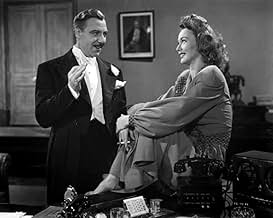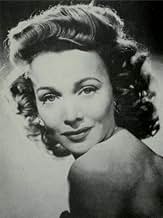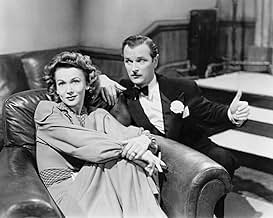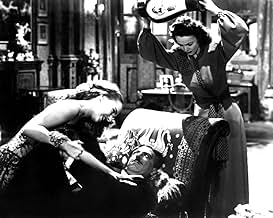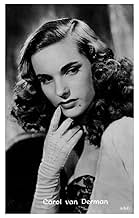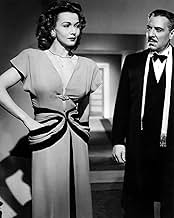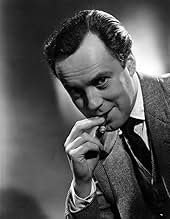Añade un argumento en tu idiomaIn post- WW2 Britain, an American fashion journalist, her ex-army fiancé, and a gang of honest toughs from a local gym attempt to bring black market organized crime to justice.In post- WW2 Britain, an American fashion journalist, her ex-army fiancé, and a gang of honest toughs from a local gym attempt to bring black market organized crime to justice.In post- WW2 Britain, an American fashion journalist, her ex-army fiancé, and a gang of honest toughs from a local gym attempt to bring black market organized crime to justice.
- Dirección
- Guión
- Reparto principal
Carol van Derman
- Mercia Lane
- (as Carol Van Derman)
Reseñas destacadas
Being vaguely aware of this obscure British noir, I had acquired it a few years ago from a film buff friend of mine (who also happens to be an award-winning lyricist) following a biography shown on local TV of Maltese film actor Joseph Calleia. It had not occurred to me to include the film in my ongoing Thriller marathon; however, I could not very well leave it out once I read, just a couple of days ago, an article about "Time Out"'s recent "100 Best British Films" in which contributor/French film director Bertrand Tavernier bemoaned there not being enough room in his Top 10 list for, among others, NOOSE! I was under the mistaken impression that the copy I got was of inferior quality which would not best be suited for display on my 40" monitor which is why I watched it on a much smaller screen but, as it turned out, the film did get released on DVD in the UK.
Adapted from his own stage play by Welsh writer Richard Llewellyn (best-known for having penned John Ford's 1941 Oscar-laden HOW GREEN WAS MY VALLEY), the film largely escapes its theatrical roots thanks to Greville's admirably Expressionistic direction that should have earned it a much better reputation (even among fans of the genre and film buffs in general) virtually comparable to that nowadays enjoyed by Alberto Cavalcanti's THEY MADE ME A FUGITIVE (1947) and Jules Dassin's similarly Soho-set NIGHT AND THE CITY (1950; with a wrestling back-drop to NOOSE's prizefighting milieu)! Actually, I do think there is a reason for this neglect since, rather than the relentless post-war bleakness and realism associated with this type of film, there is a welcome air of theatricality (in the acting) and light-heartedness (in the comic incidents that crop up intermittently).
Carole Landis, who for some reason is forever losing her shoes, is a bit too jovial for a noir heroine; ironically, she would die a suicide later in the year, after completing BRASS MONKEY (1948), another genre effort which I hope to acquire (and include) in my current schedule. Derek Farr, too, is a bland leading man – though, as already mentioned, he manages to organize a boxing outfit into efficient opposition to the gangsters involved. On the other hand, Joseph Calleia has one of his better roles: atypically, he received before-the-title billing for this rare foray to the U.K. (incidentally, at the time, our native country was a British colony) and is constantly breaking into Italian and singing operatic arias; though something of a caricature (especially in those scenes featuring his luscious starlet protégée Carol Van Derman), his is an impressive performance regardless. Despite figuring way down in the cast list, Nigel Patrick is really the protagonist as Calleia's right-hand man: he brings such manic energy to the role that it would not be amiss in a screwball comedy!; in fact, on the strength of this, I managed to get hold of Patrick's intriguing self-directed religious parable JOHNNY NOBODY (1961). Stanley Holloway, then, tackles an unusually serious role as the cop on Calleia's trail, while Hay Petrie gives a memorably chilling portrayal as Calleia's combination of private barber and assassin (actually looking a bit like Claude Rains!).
One last thing: I watched this very late at night, believing it to be just 76 minutes long as given on the IMDb: presumably, this duration alludes to the U.S. release print that was re-titled THE SILK NOOSE – being a reference to Petrie's murder 'weapon'; however, the copy I acquired turned out to be the full-length British version running 98 minutes.
Adapted from his own stage play by Welsh writer Richard Llewellyn (best-known for having penned John Ford's 1941 Oscar-laden HOW GREEN WAS MY VALLEY), the film largely escapes its theatrical roots thanks to Greville's admirably Expressionistic direction that should have earned it a much better reputation (even among fans of the genre and film buffs in general) virtually comparable to that nowadays enjoyed by Alberto Cavalcanti's THEY MADE ME A FUGITIVE (1947) and Jules Dassin's similarly Soho-set NIGHT AND THE CITY (1950; with a wrestling back-drop to NOOSE's prizefighting milieu)! Actually, I do think there is a reason for this neglect since, rather than the relentless post-war bleakness and realism associated with this type of film, there is a welcome air of theatricality (in the acting) and light-heartedness (in the comic incidents that crop up intermittently).
Carole Landis, who for some reason is forever losing her shoes, is a bit too jovial for a noir heroine; ironically, she would die a suicide later in the year, after completing BRASS MONKEY (1948), another genre effort which I hope to acquire (and include) in my current schedule. Derek Farr, too, is a bland leading man – though, as already mentioned, he manages to organize a boxing outfit into efficient opposition to the gangsters involved. On the other hand, Joseph Calleia has one of his better roles: atypically, he received before-the-title billing for this rare foray to the U.K. (incidentally, at the time, our native country was a British colony) and is constantly breaking into Italian and singing operatic arias; though something of a caricature (especially in those scenes featuring his luscious starlet protégée Carol Van Derman), his is an impressive performance regardless. Despite figuring way down in the cast list, Nigel Patrick is really the protagonist as Calleia's right-hand man: he brings such manic energy to the role that it would not be amiss in a screwball comedy!; in fact, on the strength of this, I managed to get hold of Patrick's intriguing self-directed religious parable JOHNNY NOBODY (1961). Stanley Holloway, then, tackles an unusually serious role as the cop on Calleia's trail, while Hay Petrie gives a memorably chilling portrayal as Calleia's combination of private barber and assassin (actually looking a bit like Claude Rains!).
One last thing: I watched this very late at night, believing it to be just 76 minutes long as given on the IMDb: presumably, this duration alludes to the U.S. release print that was re-titled THE SILK NOOSE – being a reference to Petrie's murder 'weapon'; however, the copy I acquired turned out to be the full-length British version running 98 minutes.
Joseph Calleia and Nigel Patrick have built up a massive and occasionally underworld organization. When one of their murders comes to the attention of reporter Carole Landis, she begins a series of newspaper articles. Their increasingly threatening reaction does not faze her, but it leads her boyfriend, Derek Farr, into organizing an armed rebellion. In the meantime, slogging police inspector Stanley Holloway is closing in from his own end.
The script is by Richard Llewellyn, based on his stage play. It's been properly opened up for the screen. The problem is that it's shifting tone, from comedy to drama, never quite works. Joseph Calleia, fine actor that he is, is saddled with a heavy accent and tries to be simultaneously funny and terrifying. Patrick's character spends a lot of time as a fast-talking Cockney, more interested in performing his comedy bits on the telephone, until he decides to suddenly take matters into his own hands and take charge.
The result is a movie that is never quite sure what it wants to be, and tries to distract the audience from that uncertainty.
The script is by Richard Llewellyn, based on his stage play. It's been properly opened up for the screen. The problem is that it's shifting tone, from comedy to drama, never quite works. Joseph Calleia, fine actor that he is, is saddled with a heavy accent and tries to be simultaneously funny and terrifying. Patrick's character spends a lot of time as a fast-talking Cockney, more interested in performing his comedy bits on the telephone, until he decides to suddenly take matters into his own hands and take charge.
The result is a movie that is never quite sure what it wants to be, and tries to distract the audience from that uncertainty.
The Silk Noose, or Noose, as it is also known, from 1948 is a British film starring Carole Landis as a fashion writer for a newspaper.
It's post-war Britain, and despite the war being over, there are many items that are hard to get. An Italian black market racketeer, Sugiani (Calleia) runs an operation in black market goods. So far, the police haven't been able to get them.
A fashion writer, Linda Medbury (Landis), is determined to bring down the gang, although her publisher would rather she stick to clothes. The front for the group, The Blue Moon Club, winds up with a corpse, which sends Linda's reporter tentacles high.
Linda finds herself in danger as does her source. Her fiance is determined to protect her and bring down Sugiani at the same time. It won't be easy.
Sometimes this film seemed like a comedy, particularly with the rapid fire dialogue of Nigel Patrick as a cohort of Sugiani's, and a woman losing her dress toward the end of the film. The last twenty or so minutes has a lot of action.
This was the beautiful Landis' second-last film. What a waste of talent. She gives a vivacious, likeable performance here. Unfortunately, her career fell on hard times when she ended her relationship with Darryl F. Zanuck. Unhappy with her career and misguided in her search for love, she committed suicide. Life in Hollywood for a woman was always extremely difficult, and she was one of its victims.
It's post-war Britain, and despite the war being over, there are many items that are hard to get. An Italian black market racketeer, Sugiani (Calleia) runs an operation in black market goods. So far, the police haven't been able to get them.
A fashion writer, Linda Medbury (Landis), is determined to bring down the gang, although her publisher would rather she stick to clothes. The front for the group, The Blue Moon Club, winds up with a corpse, which sends Linda's reporter tentacles high.
Linda finds herself in danger as does her source. Her fiance is determined to protect her and bring down Sugiani at the same time. It won't be easy.
Sometimes this film seemed like a comedy, particularly with the rapid fire dialogue of Nigel Patrick as a cohort of Sugiani's, and a woman losing her dress toward the end of the film. The last twenty or so minutes has a lot of action.
This was the beautiful Landis' second-last film. What a waste of talent. She gives a vivacious, likeable performance here. Unfortunately, her career fell on hard times when she ended her relationship with Darryl F. Zanuck. Unhappy with her career and misguided in her search for love, she committed suicide. Life in Hollywood for a woman was always extremely difficult, and she was one of its victims.
American journalist Linda Medbury may be on the staff of a London newspaper to cover the fashion column but this is not going to stop her covering other stories that she comes across. However when she gets onto the extensive racket run by Sugiani, nobody can convince her of the plain and simple fate that has come to anyone who has gone toe-to-toe with his operation. So while Linda continues to work to expose Sugiani for who he is, her military boyfriend Captain "Jumbo" Hyde gathers many men as he can from his associates to protect her in place of a police force defeated before they begin by corruption.
This summer the BBC delivered a season of British films and, to their credit it was not the usual parade of Dam Busters, Zulu and other Bank Holiday favourites but rather an interesting mix of films that are rarely seen. With 26 votes to its name on this site, it is perhaps fair to say that The Noose was one of these. The style of the film is a bit mixed. At times it appears to be every inch a British version of the American gangster film but then at others it is more of a comedy with cheeky chappy clichés kicking around in the shadows. As a result it doesn't totally hang together and I found myself distracted and my interest broken up by the inconsistent tone.
However it is still of interest and does have scenes of value. We do get moments that are easily comparable with the strongest from American noir and we do get amusing characters that remind us where we are but again, these things seem to be working against one another. Gréville's direction is good in regards working with his cinematographer but in terms of solving the issues over the narrative flow, he cannot. Nor can the cast either, and many of them seem to be in different films unfortunately. Landis is enjoyable in the lead she has what the experts would call "spunk" and it brought a bit of spark to the film. Farr is no more than serviceable and sadly the film sags when he is the focus. Calleia is a solid villain but the problem is that he isn't playing it straight and tough and he has an air of flamboyance about him. There is nothing wrong with him in this regard it is just that, within this film it is Nigel Patrick that dominates that sort of area with a wonderfully comic caricature that he works well.
An interesting film to see then for its attempts to do what it does within a British context but it is the inability to either hold a consistent tone or blend the different ones successfully that sees it be a lesser film than I would have hoped. I would have liked to be able to praise it on account of it being obscure and thus me looking cool but as it is it is interesting but not all that great.
This summer the BBC delivered a season of British films and, to their credit it was not the usual parade of Dam Busters, Zulu and other Bank Holiday favourites but rather an interesting mix of films that are rarely seen. With 26 votes to its name on this site, it is perhaps fair to say that The Noose was one of these. The style of the film is a bit mixed. At times it appears to be every inch a British version of the American gangster film but then at others it is more of a comedy with cheeky chappy clichés kicking around in the shadows. As a result it doesn't totally hang together and I found myself distracted and my interest broken up by the inconsistent tone.
However it is still of interest and does have scenes of value. We do get moments that are easily comparable with the strongest from American noir and we do get amusing characters that remind us where we are but again, these things seem to be working against one another. Gréville's direction is good in regards working with his cinematographer but in terms of solving the issues over the narrative flow, he cannot. Nor can the cast either, and many of them seem to be in different films unfortunately. Landis is enjoyable in the lead she has what the experts would call "spunk" and it brought a bit of spark to the film. Farr is no more than serviceable and sadly the film sags when he is the focus. Calleia is a solid villain but the problem is that he isn't playing it straight and tough and he has an air of flamboyance about him. There is nothing wrong with him in this regard it is just that, within this film it is Nigel Patrick that dominates that sort of area with a wonderfully comic caricature that he works well.
An interesting film to see then for its attempts to do what it does within a British context but it is the inability to either hold a consistent tone or blend the different ones successfully that sees it be a lesser film than I would have hoped. I would have liked to be able to praise it on account of it being obscure and thus me looking cool but as it is it is interesting but not all that great.
I rated this film with 6/10 mainly because the final punch-up by the boxers with the mobster gang was inconsistent, being almost comic slapstick with what had gone before involving which involved killings.As is commonly known Carole Landis had been a girlfriend of Rex Harrison and possibly through blighted affection committed suicide the same year as this film aged 29.Nigel Patrick plays an immoral cockney spiv not so ruthless as his partner an Italian gangster played by Joseph Calleia who is prone to lapse into "Don Giovanni" by Mozart occasionally.Stanley Holloway as the detective plays his part without any of the humour found in many other of his film portrayals.Derek Farr gives an unremarkable workman-like performance as the fiancé of Carole Landis.
I was surprised to find this full length 1948 film on Youtube probably because it is in the public domain and therefore out of copyright.
I was surprised to find this full length 1948 film on Youtube probably because it is in the public domain and therefore out of copyright.
¿Sabías que...?
- Curiosidades"Noose" was filmed in England during January and February of 1948. This was the final movie Carole Landis made before her death.
- ConexionesFeatured in Las películas de mi vida, por Bertrand Tavernier (2016)
- Banda sonoraWhen Love Has Passed You By
Composed by Edward Dryhurst
Lyrics by Barry Gray and Jean Cavall
Performed by Olive Lucius (uncredited)
Selecciones populares
Inicia sesión para calificar y añadir a tu lista para recibir recomendaciones personalizadas
Detalles
- Fecha de lanzamiento
- País de origen
- Idiomas
- Títulos en diferentes países
- The Silk Noose
- Localizaciones del rodaje
- Warner Brothers First National Studios, Teddington Studios, Teddington, Middlesex, Inglaterra, Reino Unido(studio: made at Warner Bros. First National Studios, Teddington, England.)
- Empresas productoras
- Ver más compañías en los créditos en IMDbPro
- Duración
- 1h 16min(76 min)
- Color
- Relación de aspecto
- 1.37 : 1
Contribuir a esta página
Sugerir un cambio o añadir el contenido que falta

